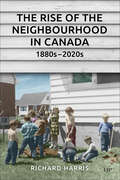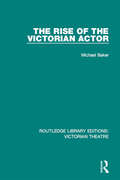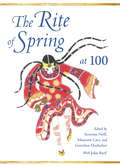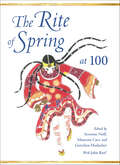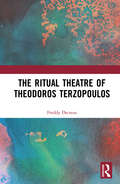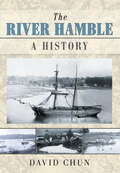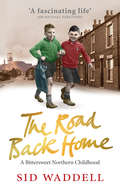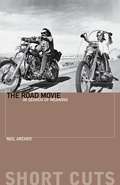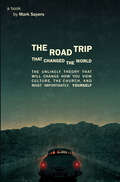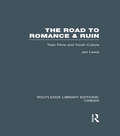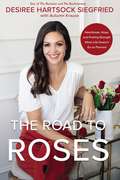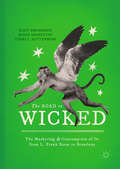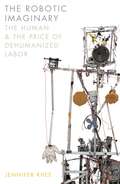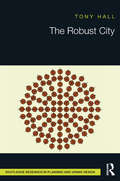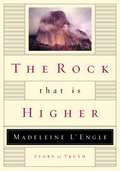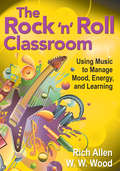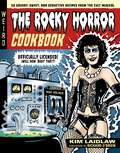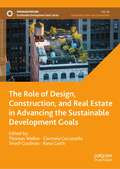- Table View
- List View
The Rise of the Modern Yiddish Theater: Avrom Goldfaden And The Jewish Stage (Jews Of Eastern Europe Ser.)
by Alyssa QuintJewish Book Award Finalist: &“Turns the fascinating life of Avrom Goldfaden into a multi-dimensional history of the Yiddish theater&’s formative years.&” —Jeffery Veidinger, author of Jewish Public Culture in the Late Russian Empire In this book, Alyssa Quint focuses on the early years of the modern Yiddish theater, from roughly 1876 to 1883, through the works of one of its best-known and most colorful figures, Avrom Goldfaden. Goldfaden (né Goldenfaden, 1840-1908) was one of the first playwrights to stage a commercially viable Yiddish-language theater, first in Romania and then in Russia. Goldfaden&’s work was rapidly disseminated in print and his plays were performed frequently for Jewish audiences. Sholem Aleichem considered him as a forger of a new language that &“breathed the European spirit into our old jargon.&” Quint uses Goldfaden&’s theatrical works as a way to understand the social life of Jewish theater in Imperial Russia. Through a study of his libretti, she looks at the experiences of Russian Jewish actors, male and female, to explore connections between culture as artistic production and culture in the sense of broader social structures. Quint explores how Jewish actors who played Goldfaden&’s work on stage absorbed the theater into their everyday lives. Goldfaden&’s theater gives a rich view into the conduct, ideology, religion, and politics of Jews during an important moment in the history of late Imperial Russia.
The Rise of the Neighbourhood in Canada, 1880s–2020s
by Richard HarrisNeighbourhoods matter now more than ever before. They sustain fewer social connections, but in an era of great social inequality and high levels of immigration, they have become vital as places for homeowner investment and educational opportunity for children. The Rise of the Neighbourhood in Canada, 1880s–2020s traces the changing character and significance of Canadian urban neighbourhoods, city and suburban, since the 1880s. The book highlights patterns in neighbourhood life, particularly noticeable in larger urban areas, which are especially important for the least mobile people: workers, lower income households, immigrants, women, children, and the elderly. It explores how the physical and social characteristics of neighbourhoods affect public health, crime rates, social capital, and job opportunities while shaping the lifelong prospects of children. Analysing long-term trends, the book examines the importance of communications technology in the context of rising inequality and immigration. It shows how, as homeownership rose, neighbourhoods became vital settings for investment, increasingly financialized, reducing affordability. Using examples from all types of neighbourhoods in cities small and large, from St. John’s through Montreal and Winnipeg to Victoria, The Rise of the Neighbourhood in Canada argues that the current prominence of neighbourhoods will persist.
The Rise of the Victorian Actor (Routledge Library Editions: Victorian Theatre #1)
by Michael BakerOriginally published in 1978. Between 1830 and 1890 the English theatre became recognisably modern. Standards of acting and presentation improved immeasurably, new playwrights emerged, theatres became more comfortable and more intimate and playgoing became a national pastime with all classes. The actor’s status rose accordingly. In 1830 he had been little better than a social outcast; by 1880 he had become a member of a skilled, relatively well-paid and respected profession which was attracting new recruits in unprecedented numbers. This is a social history of Victorian actors which seeks to show how wider social attitudes and developments affected the changing status of acting as a profession. Thus the stage’s relationship with the professional world and the other arts is dealt with and is followed by an assessment of the moral and religious background which played so decisive a part in contemporary attitudes to actors. The position of actresses in particular is given special consideration. Many non-theatrical sources are used here and there is a survey of salaries and working conditions in the theatre to show how the rising social status of the actor was matched by changes in his theatrical standing. A novel area of study is covered in tracing the changing social composition of the acting profession over the period and in exploring the case-histories of three generations of performers.
The Rite of Spring at 100
by Stephen Walsh Gretchen Horlacher John Reef Maureen Carr Severine NeffWhen Igor Stravinsky's ballet Le Sacre du printemps (The Rite of Spring) premiered during the 1913 Paris season of Sergei Diaghilev's Ballets Russes, its avant-garde music and jarring choreography scandalized audiences. Today it is considered one of the most influential musical works of the twentieth century. In this volume, the ballet finally receives the full critical attention it deserves, as distinguished music and dance scholars discuss the meaning of the work and its far-reaching influence on world music, performance, and culture. Essays explore four key facets of the ballet: its choreography and movement; the cultural and historical contexts of its performance and reception in France; its structure and use of innovative rhythmic and tonal features; and the reception of the work in Russian music history and theory. This version also includes audio and visual supplements designed to enhance understanding of this classic piece.
The Rite of Spring at 100 (Musical Meaning and Interpretation)
by John ReefWhen Igor Stravinsky's ballet Le Sacre du printemps (The Rite of Spring) premiered during the 1913 Paris season of Sergei Diaghilev's Ballets Russes, its avant-garde music and jarring choreography scandalized audiences. Today it is considered one of the most influential musical works of the twentieth century. In this volume, the ballet finally receives the full critical attention it deserves, as distinguished music and dance scholars discuss the meaning of the work and its far-reaching influence on world music, performance, and culture. Essays explore four key facets of the ballet: its choreography and movement; the cultural and historical contexts of its performance and reception in France; its structure and use of innovative rhythmic and tonal features; and the reception of the work in Russian music history and theory.
The Ritual Theatre of Theodoros Terzopoulos
by Freddy DecreusThe Ritual Theatre of Theodoros Terzopoulos outlines the story of the Athenian-based Attis Theatre and the way its founder and director, Theodoros Terzopoulos, introduced bio-energetic presences of the body on the stage, in an attempt to redefine and reappraise what it means today not only to have a body, but to fully be a body. Terzopoulos created a very specific attitude towards life and death, and it is this broad perspective on energy and consciousness that makes his work so appealing both to a general public and to students of arts, theatre and drama. Freddy Decreus’ study charts the career of Greece’s most acclaimed theatre director and provides a spiritual and philosophic answer in times where former Western meta-narratives have failed.
The River Hamble: A History
by David ChunThe Hamble rises at Bishop’s Waltham in Hampshire and flows into Southampton Water. It is a relatively small river but it has an interesting and varied history. Above Botley, the Hamble powered a number of mills, and in the 17th century plans to make that section navigable were contemplated. The tidal river below Botley has served as an important local conduit for the carriage of goods and commodities, particularly timber, underwood and fl our, and a number of industries, including fishing and salt production, have flourished on its banks over the centuries. King Henry V’s fleet was stationed on the river and in the 18th and 19th centuries it was an important location for naval shipbuilding, not least because of the ample supplies of timber to be found in the valley. One of Nelson’s flagships, HMS Elephant, was built there in the 1800s. The proximity of Southampton and Portsmouth meant the river was militarily important during the Second World War as well as in earlier conflicts. It also boasts a number of literary associations, particularly that of William Cobbett, who lived and farmed at Botley for a number of years at the beginning of the 19th century. The river has been a popular centre for yachting for over 100 years and there are a number of boatyards and marinas along its lower reaches today. However, despite this and other commercial development, the river is still prized for its natural beauty, and large sections are protected for their ecological and conservation value. Drawing on printed and archival sources, and with a wealth of illustrations, this book traces the river from its source to the sea.
The Road Back Home: A Northern Childhood
by Sid Waddell'I had not lived in the former pit village of Lynemouth since 1961 but the winding road north from Newcastle will always be the same nostalgic highway, each twist charged with vivid memories and powerful emotions...'So begins a story full of wonderful humour, emotional candour and hardy tales of tough times - a quietly epic family saga set amid the pit villages of the North East . It stretches from the 1920s, before Sid's parents had even met, to the final closing of the mine and his mother's death in 1999.Sid paints a picture of a colourful, tight knit community full of good times and hard work, god-fearing women and hard-drinking men. Always dominating the skyline is Auld Betty, the pit head that took the men away each day and, with a prayer, brought them back each evening. Amongst the unforgettable cast of his extended family and friends, we follow the Waddells' attempts to stay afloat and provide a better future and possible escape for youngsters like Sid.
The Road Movie: In Search of Meaning (Short Cuts)
by Neil ArcherThough often seen as one of America's native cinematic genres, the road movie has lent itself to diverse international contexts and inspired a host of filmmakers. As analyzed in this study, from its most familiar origins in Hollywood the road movie has become a global film practice, whether as a vehicle for exploring the relationship between various national contexts and American cinema, as a means of narrating different national and continental histories, or as a form of individual filmmaking expression. Beginning with key films from Depression-era Hollywood and the New Hollywood of the late 1960s and then considering its wider effect on world cinemas, this volume maps the development and adaptability of an enduring genre, studying iconic films along the way.
The Road Trip that Changed the World: The Unlikely Theory that will Change How You View Culture, the Church, and, Most Importantly, Yourself
by Mark SayersCan&’t find no satisfaction? There&’s no shortage of prescriptions for restlessness out there: Seek adventure. Live your life. Don&’t hold back.Sound familiar?The Road Trip that Changed the World is a book challenging the contemporary conviction that personal freedom and self-fulfillment are the highest good. Like the characters in a Jack Kerouac novel, we&’ve dirtied the dream of white picket fences with exhaust fumes. The new dream is the open road—and freedom. Yet we still desire the solace of faith. We like the concept of the sacred, but unwittingly subscribe to secularized, westernized spirituality. We&’re convinced that there is a deeper plot to this thing called life, yet watered-down, therapeutic forms of religion are all we choose to swallow, and our personal story trumps any larger narrative.This is the non-committal culture of the road. Though driving on freely, we have forgotten where we&’re headed. Jesus said His road is narrow. He wasn&’t some aimless nomad. He had more than just a half tank of gas—He had passion, objectives, and a destination. Do you?
The Road Trip that Changed the World: The Unlikely Theory that will Change How You View Culture, the Church, and, Most Importantly, Yourself
by Mark SayersCan&’t find no satisfaction? There&’s no shortage of prescriptions for restlessness out there: Seek adventure. Live your life. Don&’t hold back.Sound familiar?The Road Trip that Changed the World is a book challenging the contemporary conviction that personal freedom and self-fulfillment are the highest good. Like the characters in a Jack Kerouac novel, we&’ve dirtied the dream of white picket fences with exhaust fumes. The new dream is the open road—and freedom. Yet we still desire the solace of faith. We like the concept of the sacred, but unwittingly subscribe to secularized, westernized spirituality. We&’re convinced that there is a deeper plot to this thing called life, yet watered-down, therapeutic forms of religion are all we choose to swallow, and our personal story trumps any larger narrative.This is the non-committal culture of the road. Though driving on freely, we have forgotten where we&’re headed. Jesus said His road is narrow. He wasn&’t some aimless nomad. He had more than just a half tank of gas—He had passion, objectives, and a destination. Do you?
The Road to Romance and Ruin: Teen Films and Youth Culture (Routledge Library Editions: Cinema)
by Jon LewisThis book analyses the teen film as the rare medium able to represent the otherwise chaotic and conflicting experience of youth. The author focuses on six major issues: alienation, deviance and delinquency, sex and gender, the politics of consumption, the apolitics of youth(ful) rebellion, and regression into nostalgia. Despite the many differences within the genre, this book sees all teen films as focused on a single social concern: the breakdown of traditional forms of authority – school, church, family. Working with the theories of such diverse scholars as Kenneth Keniston, Bruno Bettelheim, Erik Erikson, Theodor Adorno, Simon Frith, and Dick Hebdige, the author draws an innovative and flexible model of a cultural history of youth. Originally published in 1992.
The Road to Roses: Heartbreak, Hope, and Finding Strength When Life Doesn't Go as Planned
by Desiree Hartsock SiegfriedWhen Desiree Hartsock was offered the opportunity to star on The Bachelorette, she thought she was finally getting the life she always longed for. Yet her reality TV dreams gave way to rough roads of unexpected twists, public scrutiny, and rejection. Now for the first time, Desiree reveals in this rivetingly honest book how she found her resilience and love after all--and you can too. Desiree Hartsock was living paycheck to paycheck and freshly--not to mention painfully--single when she first stepped onto the set of The Bachelor. Then when she was selected to star as The Bachelorette, she thought surely this turn of events promised a second chance. Yet Desiree's debut on the world stage also meant facing the critics, as viewers judged her every word and action. She was devastated when Brooks broke up with her and the entire world observed her humiliation. But what the world didn't see was the comeback journey that followed. The Road to Roses reveals: The emotional journey behind the events that played out on cameraThe mindset changes that kept Desiree open to love and trust even after heartbreak, that ultimately led her to choosing her husbandAnd the off-camera journey of the lessons Desiree learned, like how to always fail forward, stay true to yourself, and trusting that despite the external pressures, God loves us just as we areFor anyone who is looking at the pieces of their lives and losing hope that they can be put back together again, The Road to Roses offers an authentic guide for finding your grit to keep going and make yourself proud no matter what pressures you face. Whether your heart has been broken, your dream has been put on hold, or your character is being put under pressure, following Desiree's journey will give you courage to stay strong in your own.
The Road to Wicked: The Marketing and Consumption of Oz from L. Frank Baum to Broadway
by Susan Aronstein Kent Drummond Terri L. RittenburgThe Road to Wicked examines the long life of the Oz myth. It is both a study in cultural sustainability— the capacity of artists, narratives, art forms, and genres to remain viable over time—and an examination of the marketing machinery and consumption patterns that make such sustainability possible. Drawing on the fields of macromarketing, consumer behavior, literary and cultural studies, and theories of adaption and remediation, the authors examine key adaptations and extensions of Baum’s 1900 novel. These include the original Oz craze, the MGM film and its television afterlife, Wicked and its extensions, and Oz the Great and Powerful—Disney’s recent (and highly lucrative) venture that builds on the considerable success of Wicked. At the end of the book, the authors offer a foundational framework for a new theory of cultural sustainability and propose a set of explanatory conditions under which any artistic experience might achieve it.
The Robotic Imaginary: The Human and the Price of Dehumanized Labor
by Jennifer RheeTracing the connections between human-like robots and AI at the site of dehumanization and exploited labor The word robot—introduced in Karel Čapek&’s 1920 play R.U.R.—derives from rabota, the Czech word for servitude or forced labor. A century later, the play&’s dystopian themes of dehumanization and exploited labor are being played out in factories, workplaces, and battlefields. In The Robotic Imaginary, Jennifer Rhee traces the provocative and productive connections of contemporary robots in technology, film, art, and literature. Centered around the twinned processes of anthropomorphization and dehumanization, she analyzes the coevolution of cultural and technological robots and artificial intelligence, arguing that it is through the conceptualization of the human and, more important, the dehumanized that these multiple spheres affect and transform each other.Drawing on the writings of Alan Turing, Sara Ahmed, and Arlie Russell Hochschild; such films and novels as Her and The Stepford Wives; technologies like Kismet (the pioneering &“emotional robot&”); and contemporary drone art, this book explores anthropomorphic paradigms in robot design and imagery in ways that often challenge the very grounds on which those paradigms operate in robotics labs and industry. From disembodied, conversational AI and its entanglement with care labor; embodied mobile robots as they intersect with domestic labor; emotional robots impacting affective labor; and armed military drones and artistic responses to drone warfare, The Robotic Imaginary ultimately reveals how the human is made knowable through the design of and discourse on humanoid robots that are, paradoxically, dehumanized.
The Robust City
by Tony HallCities expand, upwards and outwards, and their physical structure can last a very long time, not just tens but hundreds of years. Nevertheless, they are rarely designed for expansion. Their layout does not allow for extension or for the retrofitting of infrastructure and can constrain, and often prevent, the growth and change of activities within them - cities are not 'robust' in their design. In other words, change is not planned for but involves costly reconstruction. The Robust City argues that a robust, expandable and sustainable urban form can be deduced from planning goals. Development should not just follow public transport corridors but should not be allowed beyond walking distance from them. This would create 'green enclaves' that would permit not only recreational access but also the retrofitting of infrastructure and the efficient circulation of motor vehicles. The same principles could also be applied within neighbourhoods and to facilitate the rational handling of urban intensification.
The Rock That Is Higher: Story As Truth
by Madeleine L'Engle"We are all strangers in a strange land, longing for home, but not quite knowing what or where home is. We glimpse it sometimes in our dreams, or as we turn a corner, and suddenly there is a strange, sweet familiarity that vanishes almost as soon as it comes Madeleine L Engle, from "The Rock That Is Higher Story captures our hearts and feeds our imaginations. It reminds us who we are and where we came from. Story gives meaning and direction to our lives as we learn to see it as an affirmation of God s love and truth an acknowledgment of our longing for a rock in the midst of life s wilderness. Drawing upon her own experiences, well-known tales in literature, and selected narratives from Scripture, Madeleine L Engle gently leads the way into the glorious world of story in "The Rock That Is Higher. " Here she acknowledges universal human longings and considers how literature, Scripture, personal stories, and life experiences all point us toward our true home. "
The Rock ′n′ Roll Classroom: Using Music to Manage Mood, Energy, and Learning
by Rich Allen W. W. WoodPump up the volume to increase student learning!Picture this: a room full of boisterous students suddenly calms. A sluggish afternoon math or language arts lesson turns dynamic. Music pours from an inexpensive MP3 player, and you maintain control of your classroom without a word. Drawing on both educational and neuroscientific research, Rich Allen and W.W. Wood unlock the mystery of managing mood, energy, and learning with music in this fascinating, one-of-a-kind handbook. No matter what subject or grade you teach, The Rock ′n′ Roll Classroom provides all the notes you′ll need to shake up your classroom, including:Playlists customized for specific purposes like reducing stress or increasing focusTips and tricks for accessing all your tunes easily and inexpensivelyAnecdotes from teachers about how they use music to manage everyday situationsSample lessons for across all grade levelsGet ready to tune in to this brain-compatible learning method, engage each and every one of your students, improve the power of your instruction, boost test scores and creativity, and turn on the power of music in your classroom!"This is the book I have been waiting for! I have tried to use music in my classroom for years and have always felt like I fell short, but didn′t know how to fix it. Now I have a better understanding of how to use music in my classroom in a fun and effective way."—Pamela L. Opel, Science Curriculum SpecialistGulfport School District, Biloxi, MS"Teachers will rock their students′ day with The Rock ′n′ Roll Classroom. This comprehensive work not only applies to enhancing classroom instruction, but has a world of information on the topic of music as it affects us every day."—Beth Madison, PrincipalRobert Gray Middle School, Portland, OR
The Rock: Through the Lens: His Life, His Movies, His World
by Hiram GarciaDynamic, funny, and inspiring photos of global entertainment icon, entrepreneur, and trailblazer, Dwayne "The Rock" Johnson, featuring twenty years' worth of candids, family moments, and snapshots from film and television sets, many never-before-seen. Hiram Garcia, who has known Dwayne Johnson since college, is a longtime collaborator, producing partner, and talented photographer. As a film and television producer as well as in his role as the President of Production at Seven Bucks Productions, Garcia has unprecedented access to capture images on the sets of Seven Bucks’ films including such blockbuster hits as Jumanji: The Next Level, Jungle Cruise, Fast and Furious Presents: Hobbs & Shaw, and more. As one of his closest friends, Garcia knows Johnson inside and out, and that deep relationship informs the photographs he shares in this book. Whether it’s an action-packed photo snapped during an intense film take, or a relaxed and candid shot of Johnson with his daughters, Garcia focuses his lens on the qualities he most admires in his friend: his extraordinary work ethic, his infectious smile, his empathy and sense of humor, and the joy and determination Johnson brings to everything he does. With scores of photos—most of them never been seen before and taken over two decades—The Rock: Through the Lens: His Life, His Movies, His World is enhanced by captions revealing the inside stories behind these remarkable images.
The Rocky Horror Cookbook: 50 Savory, Sweet, and Seductive Recipes from the Cult Musical [Officially Licensed]
by Kim LaidlawFrom the depths of Dr. Frank-N-Furter's laboratory comes 50 culinary concoctions to titillate the taste buds of Rocky Horror fans, in this lip-smacking officially licensed cookbook based on the cult classic stage musical. Never worry about the likes of Brad and Janet crashing your party; there will be plenty of food for everyone with this delightful and delectable cookbook beamed directly from the galaxy Transylvania to your kitchen. Give your guests a little tease with appetizers like Magenta Mash(ed) Potato Cakes and Thrill Me Chill Me Spicy Gazpacho. The main courses—which can be served in either the dining room or bedroom—offer scintillating options like Rocky&’s Mussels, Riff Raff Ramen, and Slow-Cooked Thigh Ragu that will have you shivering in antici... ...pation. Wash it all down with a Make You a Man-hattan before biting into Midnight Double Chocolate Feature Brownies for dessert. With a foreword by Rocky Horror creator Richard O'Brien, The Rocky Horror Cookbook will have long-time fans and newly discovered creatures of the night singing in unison, "Don't dream it. Eat it."
The Role of AI in Bio-Medical Translations’ Research for the Health Care Industry: First International Conference, AIBTR 2023, Nagpur, India, September 23, 2023, Revised Selected Papers (Communications in Computer and Information Science #1987)
by Sivaram Ponnusamy Vibha Rajesh BoraThis book constitutes the revised selected papers of the First International Conference, AIBTR 2023, held in Nagpur, India, during September 22–23, 2023.The 7 full papers included in this volume were carefully reviewed and selected from 37 submissions. The papers contained in this book discuss the application of Artificial Intelligence in Biomedical Engineering for the Health Care industry.
The Role of Architects in Informal Settlements: Claiming the Right to the City
by Seyed Hossein Moeini Nastaran SedehiWith over one billion people worldwide living in informal settlements and enduring substandard housing conditions, these areas present one of the greatest urban challenges of our time. The existence of informal settlements is deeply intertwined with global issues such as climate change, war-induced displacement, and colonialism. As sustainability becomes a central focus in various disciplines, including architecture, the path to sustainable urban development lies in addressing the problems of informal settlements. Architecture's relevance to this discourse is paradoxically highlighted by its perceived 'irrelevance'. Informal settlements are often overlooked as legitimate sites for architectural practice. This neglect stems from two assumptions: first, architecture's traditional dependence on power and capital, isolating the marginalised who rarely have the chance to receive architectural services; and second, architecture's perceived incapability to address urban-scale infrastructural problems, and thereby its reduction to aesthetic creativity and form making. This book challenges architecture's focus on the 'centre' and its lack of ambition for creating a pervasive impact on cities. Instead, it highlights the profession's potential to serve the common good and address urban-scale infrastructural issues and proposes the effective engagement of architects in informal settlements. Drawing on Henri Lefebvre’s dichotomy of margin versus centre in urban spaces, informal settlements are interpreted as spaces on the city’s periphery, created by the marginalised with limited access to power, capital, and authority. By revisiting interrelated concepts such as the production of space, the right to the city, social architecture, and spatial agency within the context of informal settlements, the book claims a space for architectural practice in these areas. It incorporates discussions on insurgent citizenship and critiques of the self-help approach, contextualising its arguments with architectural intervention precedents from around the world. The book concludes with a brief manifesto on practising architecture in informal settlements. The book aspires to inspire architecture students, practitioners, and researchers to explore the profession’s potential in social problem-solving and to push the boundaries of practice towards inclusiveness for all urban inhabitants.
The Role of Art and Culture for Regional and Urban Resilience
by Philip Cooke Luciana LazzerettiThis book analyses the influence of art and culture as an engine to promote the resilience of regional and urban economies. Under a multidiscplinary perspective, the book examines the contribution of some creative regions and cities as places in which processes of transformation, innovation and growth are activated in response to external pressures. Through different theoretical frameworks and empirical investigations and suggesting a critical discussion of the notion of resilience, the authors argue that cultural and creative resources may offer a sustainable model in order to afford different typologies of shocks. The book will appeal scholars of regional and urban science and cultural and creative economies and will open up a number of considerations for policy makers.This volume was originally published as a special issue of European Planning Studies.
The Role of Design, Construction, and Real Estate in Advancing the Sustainable Development Goals (Sustainable Development Goals Series)
by Thomas Walker Sherif Goubran Carmela Cucuzzella Rana GeithThis edited book brings together insights from scholars and practitioners from many different fields to uncover the role of the construction and real estate sectors and how they align with the Sustainable Development Goals (SDGs). It follows a lifecycle-based approach to the topic, addressing the design, construction, management, investment, and regulatory dimensions of projects in the area. It expands the reader’s understanding of the built environment beyond the design and construction phases, which enables the collection to explore the links and transitions between different project phases and uncover new methodologies that aim to tackle systemic sustainable development challenges. The chapters’ comprehensive coverage allows the collection to capitalize on the strengths and weaknesses of the building industry, highlight emerging trends, and uncover some critical gaps that need to be addressed to attain the 2030 vision. This puts into perspective the interconnected nature of the SDGs and highlights the importance of multi-stakeholder collaborations in achieving them.
The Role of Fuels in Transforming Energy End-Use in Buildings and Industrial Processes (Synthesis Lectures on Engineering, Science, and Technology)
by Praveen Cheekatamarla Kyle Gluesenkamp Stephen Kowalski Zhenning Li Saad JajjaEnergy-efficient technologies are necessary to lower the carbon footprint for a transition towards clean energy in a sustainable manner. This book examines what role fuels have in the transformation of end-use in buildings and industrial processes. Energy-efficient technologies are necessary to lower the carbon footprint for a transition towards clean energy in a sustainable manner. Efficient utilization of primary energy resources, including renewables, to support the current and future energy needs while targeting grid resiliency, energy, and environmental security at an affordable cost is of significant value. The author analyzes heat pumps, fuel-driven thermal providers, and power systems configurations and looks at the sensitivity of the electrical grid's carbon intensity and tariff towards carbon footprint and energy costs compared with fuel-driven technologies. The role of low-carbon, zero-carbon, and carbon-negative fuels, such as power-to-gas (P2G), power-to-liquid (PtL), hydrogen, and biogas, in conjunction with polygeneration technologies, are discussed. This book also examines two different scenarios focused on the sensitivity of the pace of decarbonization of the electrical grid and fuel supply on operational energy-related carbon emissions.Compares electricity versus fuel as a primary energy sourceExplores the role of fuels in the decarbonization journey Examines the value proposition of currently available energy solutions

